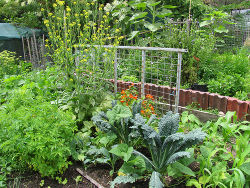Food/Permaculture
Most of the food produced nowadays in the industrialized world comes from large centralized farms that focus on a small number of crops or animals. These agricultural systems require a constant input of fertilizer, pesticide, water and other resources, and have a constant output of pesticide-contaminated runoff water and other waste.
By contrast, permaculture creates an interconnected system of flora and fauna that recycles its own resources. It is an designed ecosystem rather than a factory-style production outfit.
On a permaculture farm, different organisms work synergistically. There may be chickens that eat weeds and fertilize plants with their droppings. Food waste and inedible parts of plants are used for compost. The output of one part of the system thus becomes the input of another. There is (theoretically at least) no waste, allowing the system to be 'permanent', able to go on for millenia without adversely affecting the local ecosystem. Whereas industrial-style farming techniques deplete 6-24 kilos of soil for ever kilo of food grown, permaculture can create 20 kilos of newly fertile soil for every kilo of food grown[1].
A principle of permaculture is multiculture, growing many different plants and animals side-by-side, so that they feed off one another's resources. The different parts of the system are balanced in dynamic equilibrium. Multiculture allows higher food yields with less work than monoculture and provides humans with a greater variety of foods. Each element in a permaculture system serves multiple purposes. For example, herbs may be used in cooking, but they also host predatory insects that control pests.
Permaculture is not only an ecologically sound means of food-production, it is very efficient. Permaculture expert David Blume makes a convincing case for the efficiency of permaculture, writing, "In a good but somewhat sloppy design, you need about 500 square feet (46.5m2) per person maximum. In a very good design, 200 square feet (18.5m2) will do the job." John Jeavons (father of another school of permaculture called biointensive agriculture), makes more conservative claims of around 316-372 square meters [2] [3].
It is worth noting that climbing plants, like grapes and beans, require essentially no ground space to grow.
A surprising trend that has emerged in recent years is urban gardening: city dwellers are starting to grow food on balconies, rooftops, roadsides, parks and any little patch of bare soil they can find. Urban gardens may be part of the food puzzle in the future (and, moreover, they serve a social and recreational function) but it will require controlled-environment agriculture for cities to produce all the food they need.
While not as automated nor as productive as the aeroponics techniques described to the left, permaculture is a highly practical and advanced methodology that can play a role in making Spaceship Earth work for everybody.
